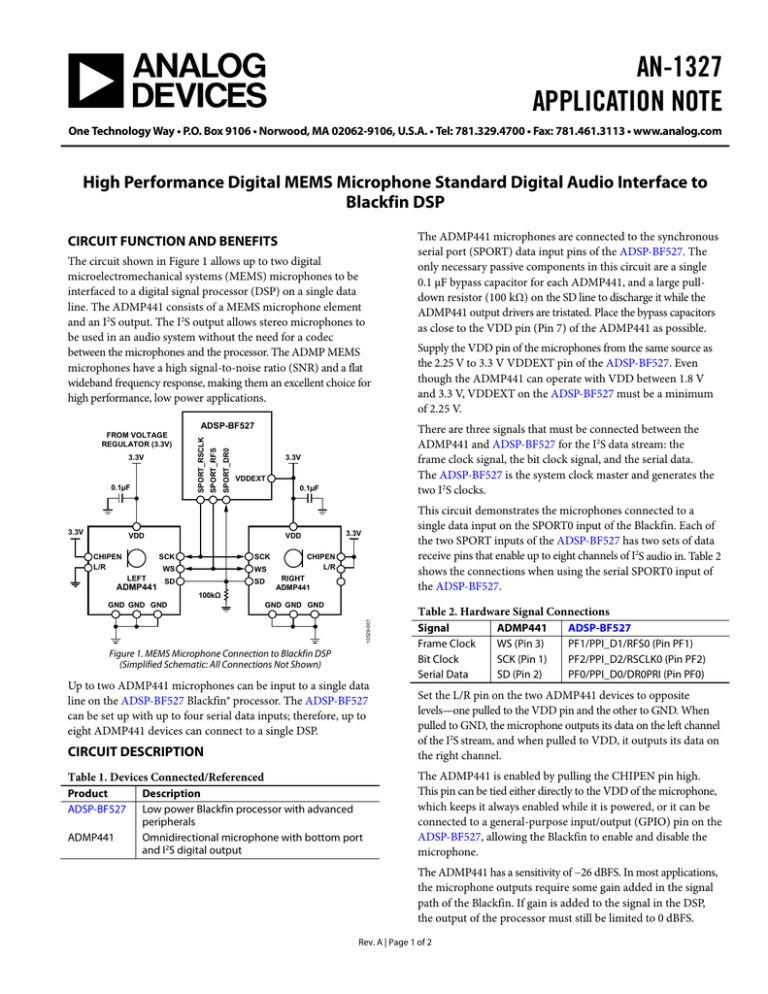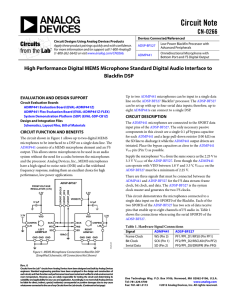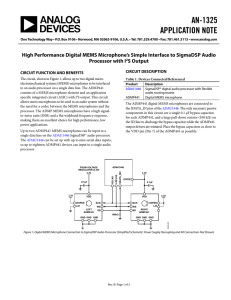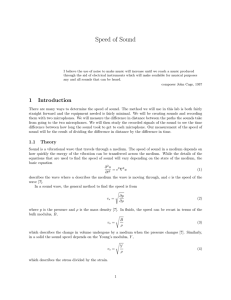AN-1327 APPLICATION NOTE
advertisement

AN-1327 APPLICATION NOTE One Technology Way • P.O. Box 9106 • Norwood, MA 02062-9106, U.S.A. • Tel: 781.329.4700 • Fax: 781.461.3113 • www.analog.com High Performance Digital MEMS Microphone Standard Digital Audio Interface to Blackfin DSP CIRCUIT FUNCTION AND BENEFITS The circuit shown in Figure 1 allows up to two digital microelectromechanical systems (MEMS) microphones to be interfaced to a digital signal processor (DSP) on a single data line. The ADMP441 consists of a MEMS microphone element and an I2S output. The I2S output allows stereo microphones to be used in an audio system without the need for a codec between the microphones and the processor. The ADMP MEMS microphones have a high signal-to-noise ratio (SNR) and a flat wideband frequency response, making them an excellent choice for high performance, low power applications. 3.3V SPORT_DR0 SPORT_RFS 0.1µF SPORT_RSCLK 3.3V 3.3V VDDEXT 0.1µF CHIPEN L/R LEFT ADMP441 SCK SCK WS WS SD SD 100kΩ CHIPEN L/R RIGHT ADMP441 GND GND GND 10529-001 GND GND GND This circuit demonstrates the microphones connected to a single data input on the SPORT0 input of the Blackfin. Each of the two SPORT inputs of the ADSP-BF527 has two sets of data receive pins that enable up to eight channels of I2S audio in. Table 2 shows the connections when using the serial SPORT0 input of the ADSP-BF527. 3.3V VDD VDD Figure 1. MEMS Microphone Connection to Blackfin DSP (Simplified Schematic: All Connections Not Shown) Up to two ADMP441 microphones can be input to a single data line on the ADSP-BF527 Blackfin® processor. The ADSP-BF527 can be set up with up to four serial data inputs; therefore, up to eight ADMP441 devices can connect to a single DSP. CIRCUIT DESCRIPTION Table 1. Devices Connected/Referenced Product ADSP-BF527 ADMP441 Supply the VDD pin of the microphones from the same source as the 2.25 V to 3.3 V VDDEXT pin of the ADSP-BF527. Even though the ADMP441 can operate with VDD between 1.8 V and 3.3 V, VDDEXT on the ADSP-BF527 must be a minimum of 2.25 V. There are three signals that must be connected between the ADMP441 and ADSP-BF527 for the I2S data stream: the frame clock signal, the bit clock signal, and the serial data. The ADSP-BF527 is the system clock master and generates the two I2S clocks. ADSP-BF527 FROM VOLTAGE REGULATOR (3.3V) The ADMP441 microphones are connected to the synchronous serial port (SPORT) data input pins of the ADSP-BF527. The only necessary passive components in this circuit are a single 0.1 µF bypass capacitor for each ADMP441, and a large pulldown resistor (100 kΩ) on the SD line to discharge it while the ADMP441 output drivers are tristated. Place the bypass capacitors as close to the VDD pin (Pin 7) of the ADMP441 as possible. Description Low power Blackfin processor with advanced peripherals Omnidirectional microphone with bottom port and I2S digital output Table 2. Hardware Signal Connections Signal Frame Clock Bit Clock Serial Data ADMP441 WS (Pin 3) SCK (Pin 1) SD (Pin 2) ADSP-BF527 PF1/PPI_D1/RFS0 (Pin PF1) PF2/PPI_D2/RSCLK0 (Pin PF2) PF0/PPI_D0/DR0PRI (Pin PF0) Set the L/R pin on the two ADMP441 devices to opposite levels—one pulled to the VDD pin and the other to GND. When pulled to GND, the microphone outputs its data on the left channel of the I2S stream, and when pulled to VDD, it outputs its data on the right channel. The ADMP441 is enabled by pulling the CHIPEN pin high. This pin can be tied either directly to the VDD of the microphone, which keeps it always enabled while it is powered, or it can be connected to a general-purpose input/output (GPIO) pin on the ADSP-BF527, allowing the Blackfin to enable and disable the microphone. The ADMP441 has a sensitivity of −26 dBFS. In most applications, the microphone outputs require some gain added in the signal path of the Blackfin. If gain is added to the signal in the DSP, the output of the processor must still be limited to 0 dBFS. Rev. A | Page 1 of 2 AN-1327 Application Note ADSP-BF527 Register Settings LEARN MORE This section lists the SPORT register settings to set the ADSP-BF527 into I2S master mode. The ADSP-BF52x Blackfin Processor Hardware Reference provides a more detailed description of these register settings. The ADMP MEMS microphone products mentioned in this application note are manufactured by InvenSense, 1745 Technology Dr., San Jose, California 95110. Configure the SPORT_RCR1 register, the primary receive configuration register, with the following nondefault settings: • • • • RCKFE: Drive internal frame sync on falling edge of RSCLK RFSR: Require RFS for every data-word IRFS: Internal RFS used IRCLK: Internal receive clock select Lewis, Jerad. AN-1112 Application Note, Microphone Specifications Explained. Analog Devices, Inc., 2013. Lewis, Jerad. Technical Article MS-2275. Common Inter-IC Digital Interfaces for Audio Data Transfer. Analog Devices, Inc., 2012. Nielsen, Jannik Hammel, and Claus Fürst. Toward More Compact Digital Microphones, Analog Dialogue Volume 41, September 2007, Analog Devices, Inc. Configure the SPORT_RCR2 register, the secondary receive configuration register, with the following nondefault settings: • • Elko, Gary W. and Kieran P. Harney. “A History of Consumer Microphones: The Electret Condenser Microphone Meets Micro-Electro-Mechanical-Systems,” Acoustics Today, 2009. RSFSE: Receive stereo frame sync enable SLEN: 32-bit word length Data Sheets and Evaluation Boards Set the SPORT_RCLKDIV register, the SPORT receive serial clock divider register, to 17 (0x0011) and set the SPORT_ RFSDIV register to 31 (0x001F). This sets the proper clock frequencies for both a 48 kHz frame clock and a 3.072 MHz bit clock, with a 120 MHz Blackfin system clock (SCLK). The register settings described can be applied to either the SPORT0 register or the SPORT1 register on the ADSP-BF527, depending on which is being used. COMMON VARIATIONS DSPs This circuit can also be set up with other parts from the Blackfin family instead of an ADSP-BF527. See the appropriate data sheets for details on the differences in number of SPORT channels and other variations. Consult the Blackfin family product page for more information. ADSP-BF527 Data Sheet ADSP-BF527 Evaluation Board (ADZS-BF527-EZLITE) ADSP-BF52x Blackfin Processor Hardware Reference REVISION HISTORY 11/14—Rev. 0 to Rev. A Changed Title of Document from CN-0266 to AN-1327 .............................................................................. Universal Deleted Evaluation and Design Support Section ..........................1 Added Table 1; Renumbered Sequentially .....................................1 Deleted Circuit Evaluation and Test Section .................................2 Changes to Learn More Section and Data Sheets and Evaluation Boards Section ...................................................................................2 1/12—Revision 0: Initial Version Microphones By removing one of the ADMP441 microphones, a mono microphone circuit using a single ADMP441 can be set up. The other connections remain the same in this mono configuration. Additional ADMP441 microphones can be connected to the SPORT inputs of the ADSP-BF527 in the same way as the first stereo pair. ©2014 Analog Devices, Inc. All rights reserved. Trademarks and registered trademarks are the property of their respective owners. AN10529-0-11/14(A) Rev. A | Page 2 of 2




